- It’s what we do
- Aussie Ron Does New Zealand
- Our Island Home
- Yamaha Ténére 700
- Northwest Or Bust
- Two In One
- Help Me If You Can
- Why, Brother? There’s Nothin’ Much There
- Touratech Compañero World 2 Suit
- 8 Blokes. 9244km. 1 Great Ride
- An Interesting Week In The Andes
- Taming Hills with Miles Davis
- Sole man with Andy Strapz
- Holding Hands with Karen Ramsay
- Fit Out – Touratech Yamaha XTZ 700 Ténéré
- Checkout
A short, one-day introduction to the newest Ténéré in issue #38 had us fizzing at the split. Early indications were the 700 was a bike ideally suited to The Land Of Sweeping Plains. After a few solid days doing just about everything the bike’s designed to do, we think the Ténéré 700 lives up to the promise.


To quickly recap our experience sofar, Yamaha Motor Australia allowed Adventure Rider Magazine a quick blast on the Ténéré 700 and we were impressed. The motor in particular made a big impact on us because it was so smooth and incredibly easy to use. We had riders of varying heights and all liked the ergos, and as we handed the bike back to the YMA guys we were left very thoughtful indeed.
Go back to issue #38 for the full read, but the summary was: ‘Thanks to some well-balanced engineering ideas it’s both comfortable and very rewarding to ride. Anyone asked to give criteria for an adventure bike to suit Australian conditions would probably end up describing a bike just like this one’.


The real deal
Now we’ve completed the official multiday media release. We’ve peeled off some reasonable bitumen kilometres,pounded through rocks and tackled some almost-single track, all of it with lots and lots of dust. After some improvisation and exploration by the Yamaha folks there was even a river found to splash through in the middle of drought-stricken NSW. The route and logistics were overseen by Greg Yager and his RideADV crew, and it was pretty much the type of riding the huge majority of Australian adventure riders would experience on 90 per cent of outings.
It wasn’t just the actual terrain that was so typical of a true adventure ride.
The riders stayed in luxurious resorts and bunked down in bug-riddled shearers’ dongas. Catering ranged from a-la-carte restaurants to soggy muesli bars carried in backpacks, and navigation was by GPS.
Riders paired up, one with a GPS and one without, and were left to find their own way through the challenges of each day.
As we said, it was very much like the riding most of us do, most of the time.
The exception was having truly incredible backup and support.
Seriously. If we could all have sweeps, leaders and minders like the ones suppliedon this ride, none of us would ever show up for work.
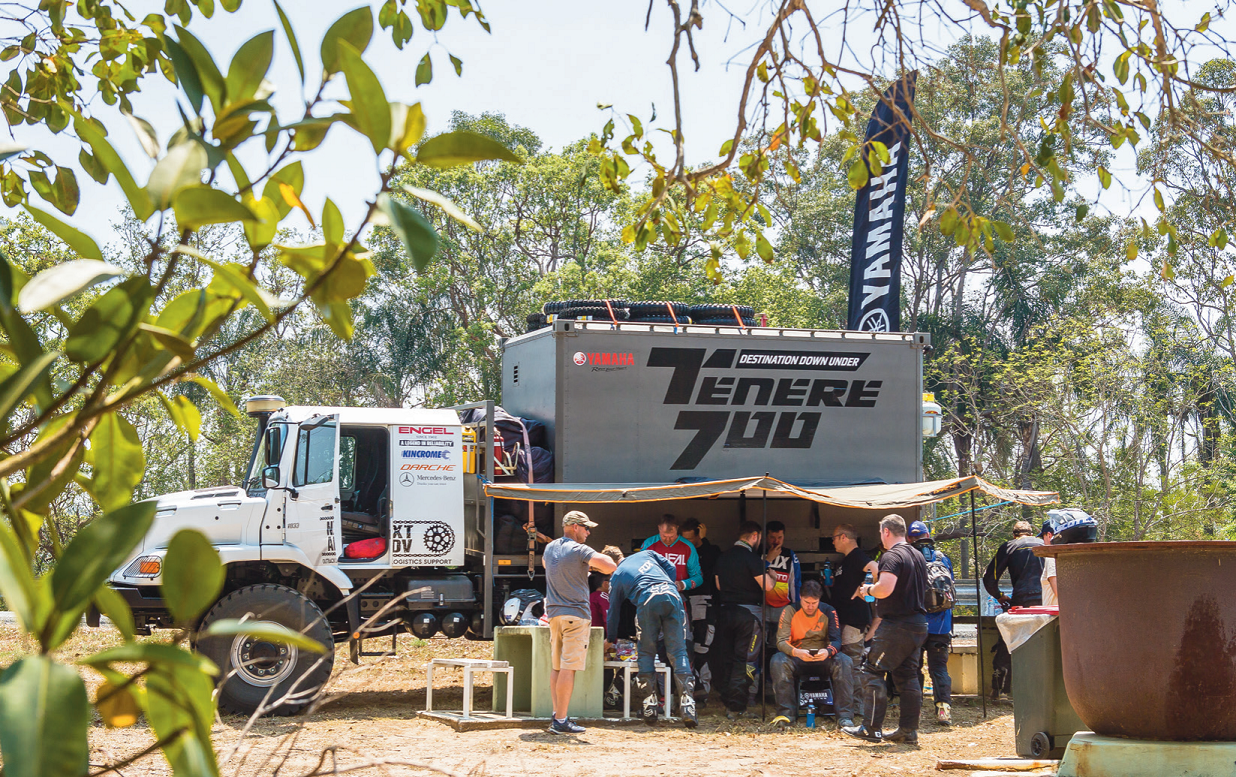

Line up
All our impressions from our first ride were unequivocally proven on this one.
The motor seems to have been planned with Australia in mind. It’s not the most powerful or spectacular powerplant in the adventure-riding world, but that’s an advantage when the days are long and the terrain is tough. The smooth power and torque delivery make the engine superbly manageable and that means a lot less fatigue for a rider when things get challenging, and a lot less wear and tear on the bike when it’s a long way between sheds and services. It also means a rider doesn’t need to be an A Grade moto-crosser to make use of what the bike has to offer. Good riders won’t be held back by the Ténéré 700, but average riders will find the forgiving nature of the drive train, from the engine through the lightish clutch and very slick six-speed gearbox, will allow them to ride at their best – as opposed to being intimidated by massive power output or overwhelming electronics.
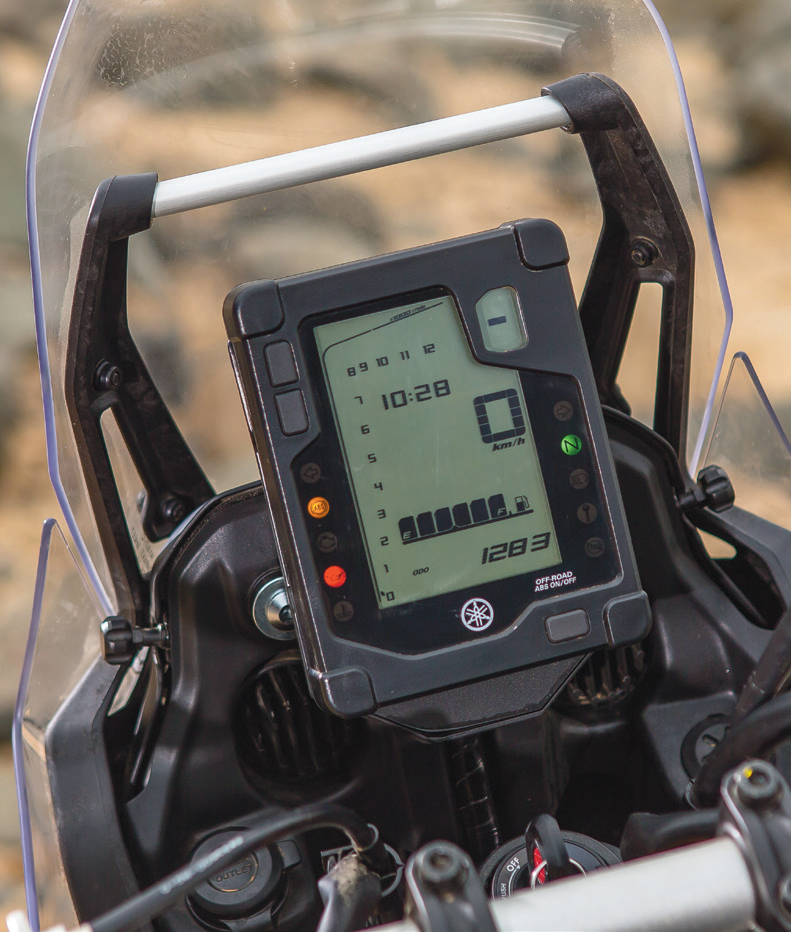

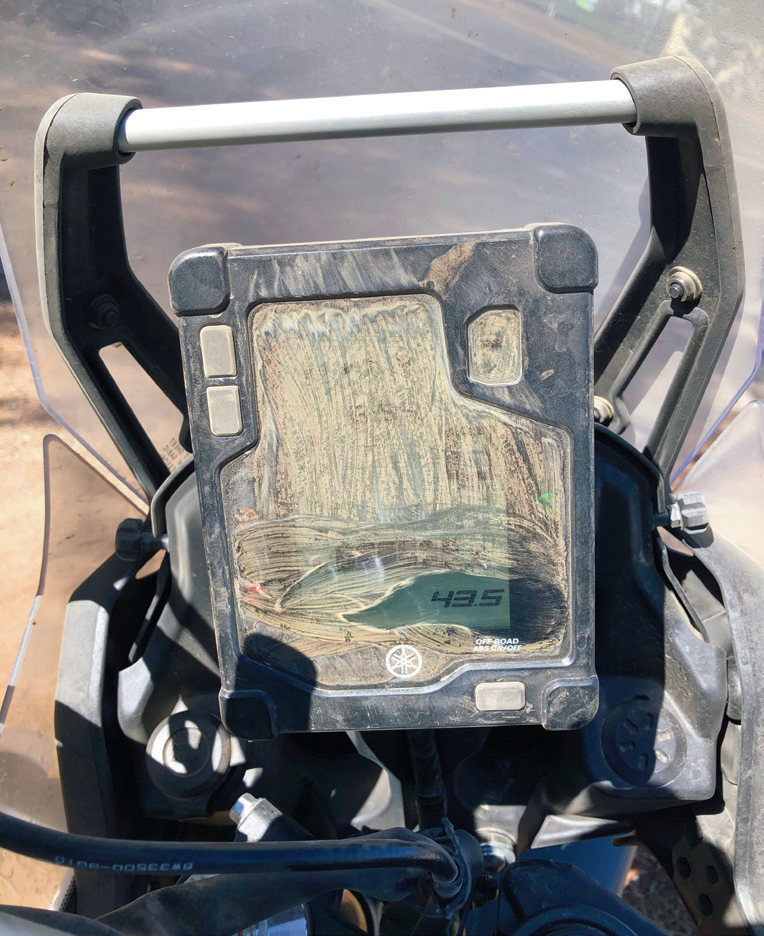

As a final thought on the mechani-cal aspects of the bike, we monitored fuel consumption and it came in at 20.5km per litre, irrespective of how hard we flogged it or what type of terrain we rode. That makes for around 320km from the 16-litre tank.
With all that said, Yamaha offered a few variations on the base-model Ténéré 700, and we’ll have a look at them one at a time.
Everything we’ve said about the bike applies to all variations, with the exception of seat heights. We rode bikes with the taller and shorter seats, and we’ll comment on them as they happened.
Overall we believe this is probably the best Ténéré Yamaha has ever offered. Its versatility is amazing, and it’s a great adventure bike as it stands on showroom floors. But it’ll be a really excellent platform for individuals to shape into the bike they’ve always wanted.
Interestingly, Yamaha has already taken a few steps in that direction….
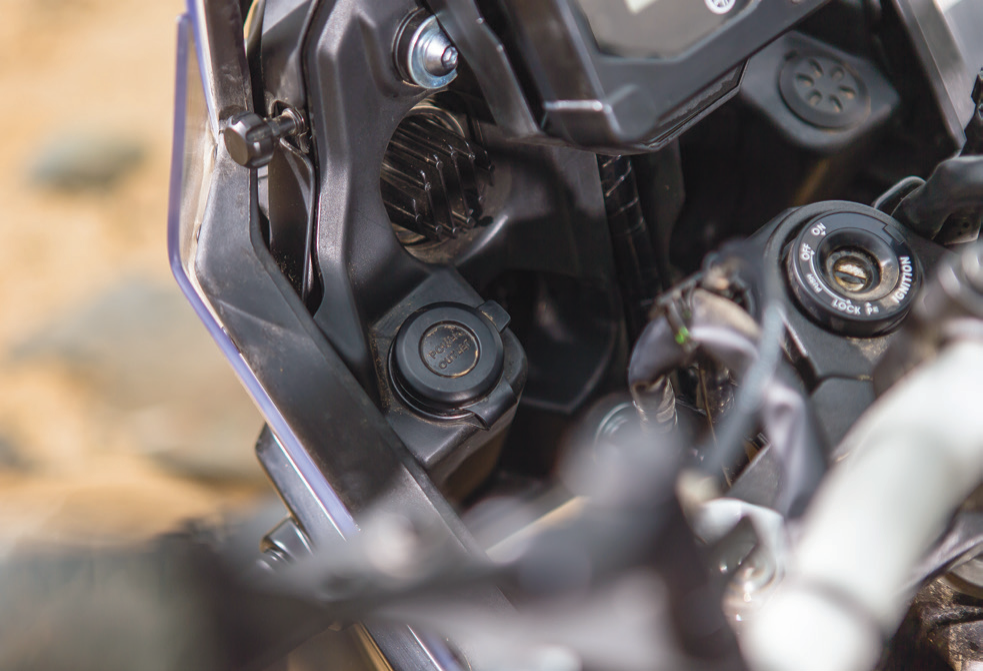

Base model
For $17,149 Australians can ride away on an unadorned, base model Ténéré 700.
The standard bike is the configuration we rode in issue #38. It has Yamaha’s 689cc, liquid-cooled, twin-cylinder CP2 motor, proven in bikes like the MT-07, and it was a definite highlight. The fuel-injection settings have been refined to suit the dualsport application of the Ténéré and the frame is a lightweight, double-cradle, tubular-steel jobbie.
The front-frame downtubes are detachable, and that’s going to be very handy for servicing and mechanical work.
Suspension is basic but sound. The front has 43mm USDs with 210mm of travel and both rebound and compression adjustment. The rear has only preload adjustment.
It was interesting to see an 18-inch rear wheel. A 21-inch front is common enough, but the 18-inch rear used to be a bonus over a 17-inch rim because it meant the availability of a much bigger range of tyres. These days the 17-inch rims are very well catered for.
In any case, the Ténéré 700 has an 18-inch rear rim.
Speaking of tyres, the standard Pirelli STRs had been swapped for Pirelli Scorpion Rallys on all the review bikes to suit the predominantly dirt route. Foam airfilters are standard in the Aussie 700s (yay!), and radiator guards and lower chain guides from the genuine Yamaha accessories catalogue were fitted to all.
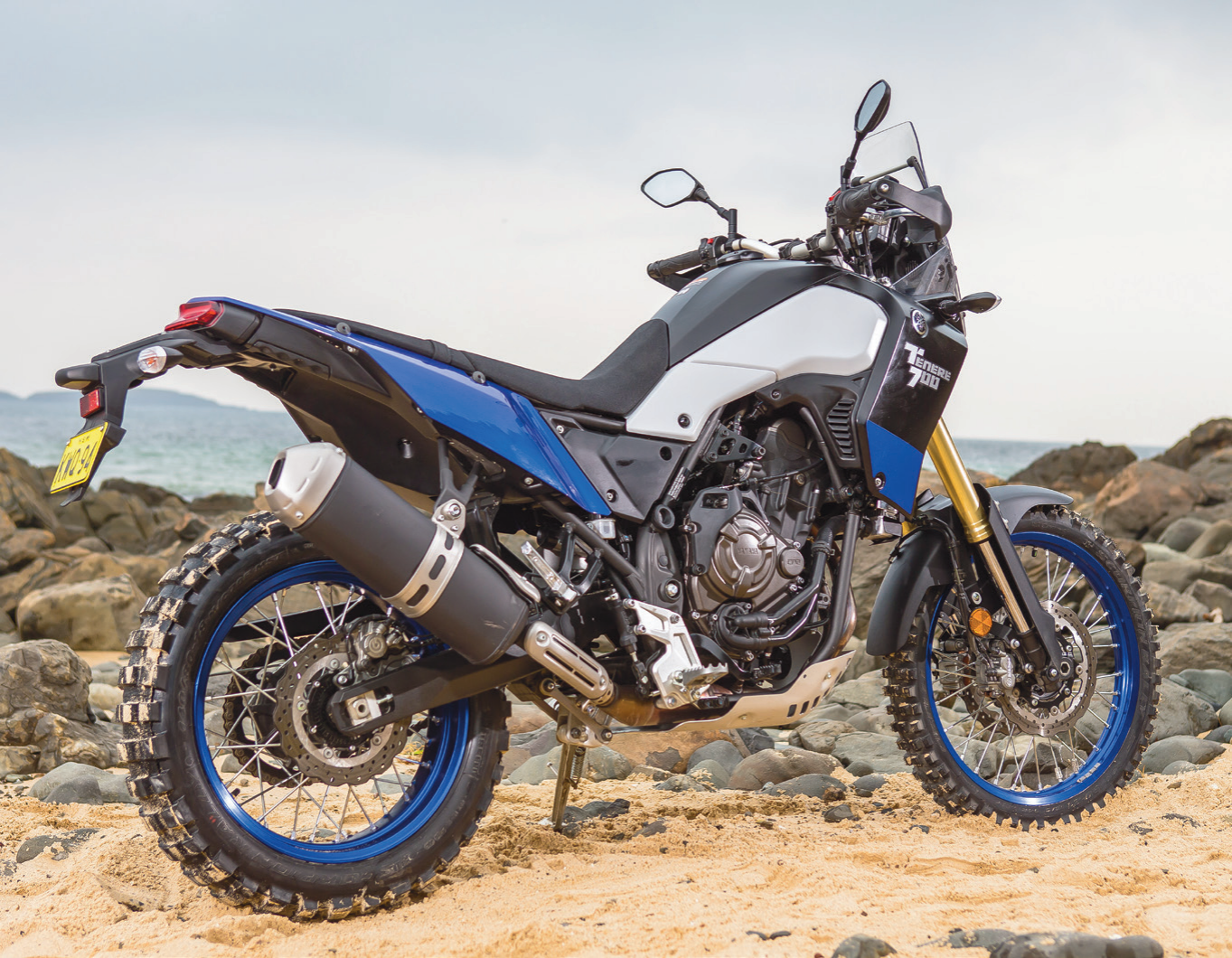

Love it
In short, the standard bike is a pearler, especially at the price.
The tricky thing for Yamaha will be writing the brochures.
These days marketing seems to be based around ever more sensationalist claims of huge horsepower figures or massively complex electronics. With the Ténéré 700 having neither of those things, we’re not sure where Yamaha will start. Saying, ‘This is a great, honest, durable and reliable adventure bike well suited to the toughest of Australian conditions’ might not sound so exciting.
Maybe not, but it’s true, and for the overwhelming majority of Australian adventure riders the standard Ténéré 700 will offer a supremely enjoyable and capable ride. The motor has plenty of everything needed to conquer huge distances or get playful.
At 204kg ready to ride the weight isn’t scary or unmanageable, and the only user-controlled electronics – ABS – are dead simple to operate. There’s a grey button on the bottom-right corner of the LCD dash marked ‘OFF ROAD ABS ON/OFF’. Just have the bike stationary and push that button. The ABS will, predictably, toggle between on and off.
That’s it. There is no menu or multifunction button to negotiate.
There’s no traction control, alternative ignition maps, electronic-suspension adjustment or phone apps either. Nor is there cruise control, which we would’ve liked, but can live without.
The dash does offer a USB power supply and a bar above the LCD panel which is ideal for mounting a GPS.


Good to go
At 870mm the seat height is good for Aussies. There’s a shorter OEM seat available which drops things to 863mm, and combined with the OEM lowering link it can drop to 845mm.
We humped a Yamaha roll-top bag full of luggage on all the bikes, and that meant the static sag was a little long to start with. Of course that lowered the seat height noticeably. But even when we cranked up the rear preload using the external knob behind the motor we still didn’t feel the seat was overly tall.
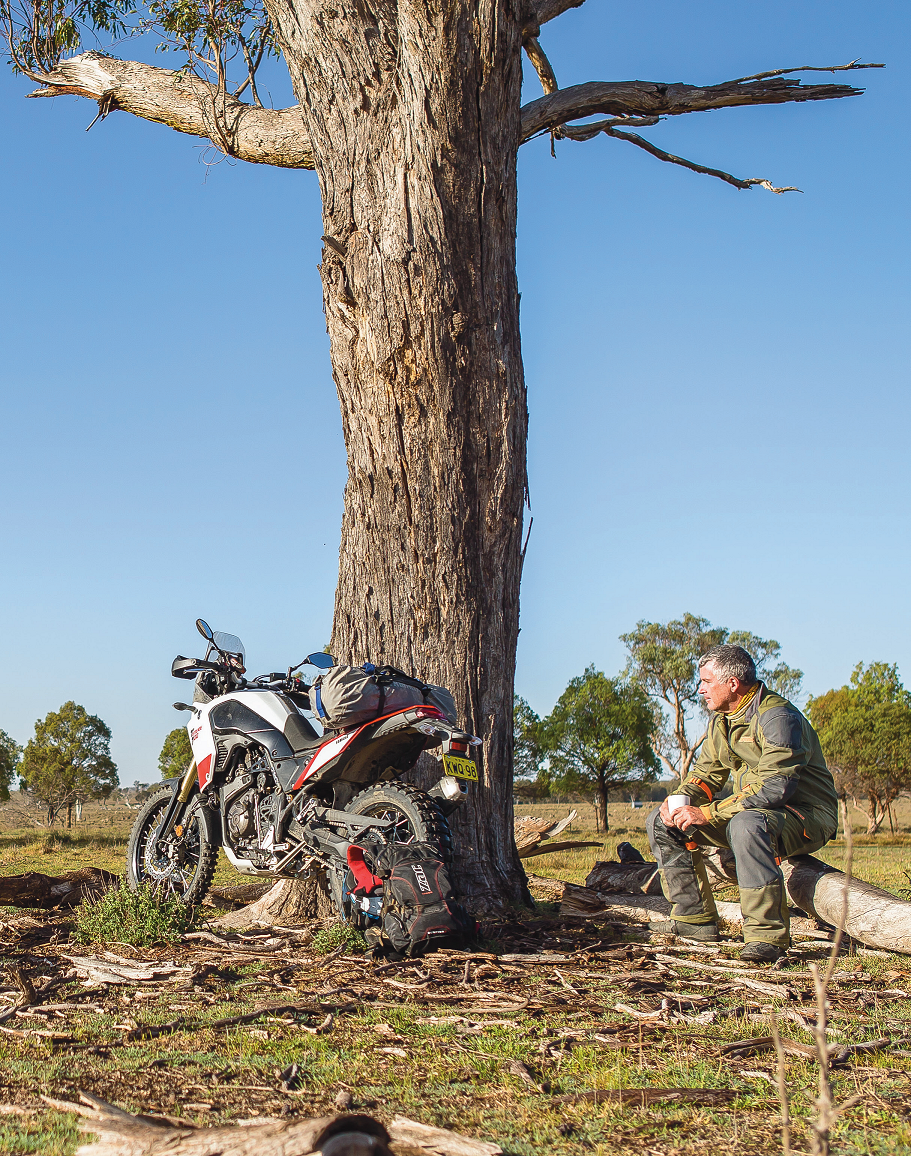

As it was, we loved the standard bike.
The motor, clutch and gearbox were an absolute joy to use, the screen kept the rider surprisingly sheltered from wind-blast and the bike generally gave a feel of low-stress reliability. It doesn’t rail berms like a WRF, but it handles well and gives the rider plenty of feedback. Braking is excellent, and we rate the ABS as top-notch. We noticed other riders constantly pulling up at the start of dirt sections to switch off the ABS, but once we’d given it a try and found how good it was, we didn’t switch it off once in the five days of riding. It allowed hard braking, even on loose surfaces, and we didn’t see any shit-scary downhills on this ride (the only thing which would make us switch off this ABS).
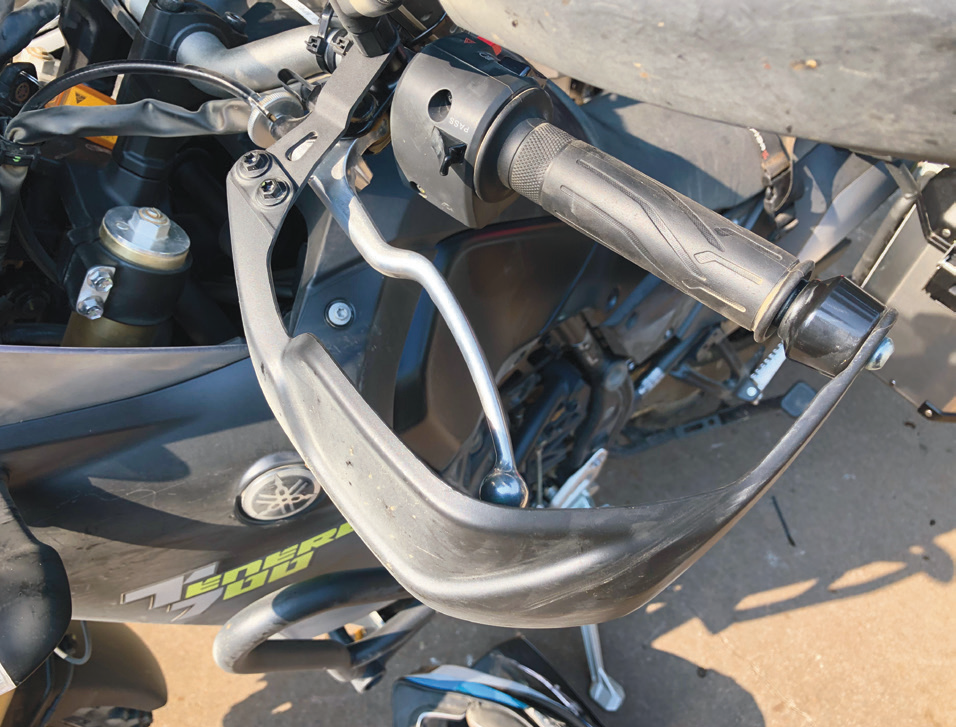

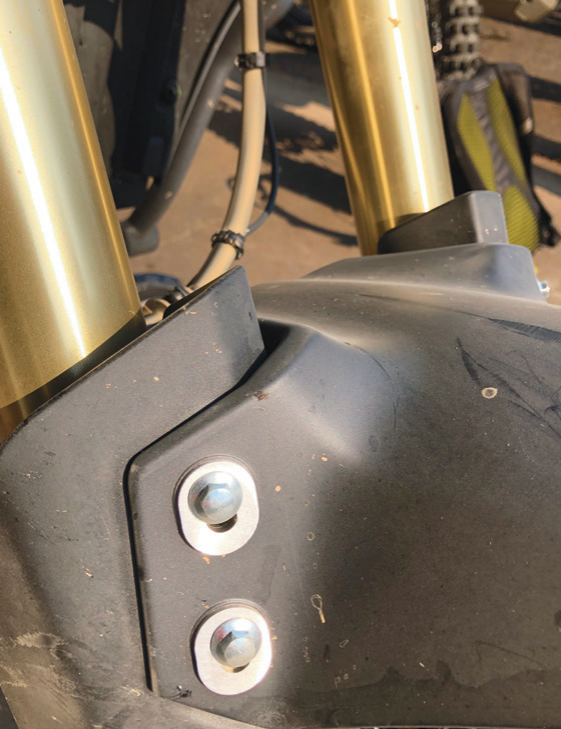

Light off-road spec
Taking the standard bike and adding a skidplate, headlight guard and tank pad moves it to the ‘light off-road’ spec.
Naturally, we didn’t feel any difference between the light off-road bike and the standard bike from a performance point of view. The ‘tank pad’ is one of those rubbery jiggers the road-bike riders use to stop buckles or press studs scratching the top of the steel tank. The headlight guard is an extra layer of lexan which sits in front of the existing – and very impressive – four-light headlight set up (we’re kicking ourselves we didn’t go for a night ride to see how good the lights were, because they look awesome) and the skidplate is a bit of a whopper. We became fans of the skidplate when a rock smashed a sidestand switch on one of the bikes. The motor, of course, wouldn’t run with the bike in gear. Thanks to the lack of high-intervention electronics we cut the wiring to the switch, twisted the two ends together, wrapped the join in insulation tape and finished the ride.
No problem, and only about 10 minutes lost to locate the fault and do the repair.
Still, the big skidplate may have meant we wouldn’t have had to deal with the problem in the first place.
As on the standard bike, the handguards are plastic shells. They secure to the ’bar ends and the ’bars themselves, and mostly protect the rider’s hand from the elements, but they’re fairly lightweight and wouldn’t cop a serious impact.
It seemed to us the light off-road spec was sensible enough, and we couldn’t feel any additional weight or change in the bike’s behavior.
The only thing we thought a little strange was being just a tiny bit cramped at the end of the day. It wasn’t until someone asked if they could please swap seats we realised we’d been on the low seat.
So the seat doesn’t make a huge difference, but the difference is clearly there.
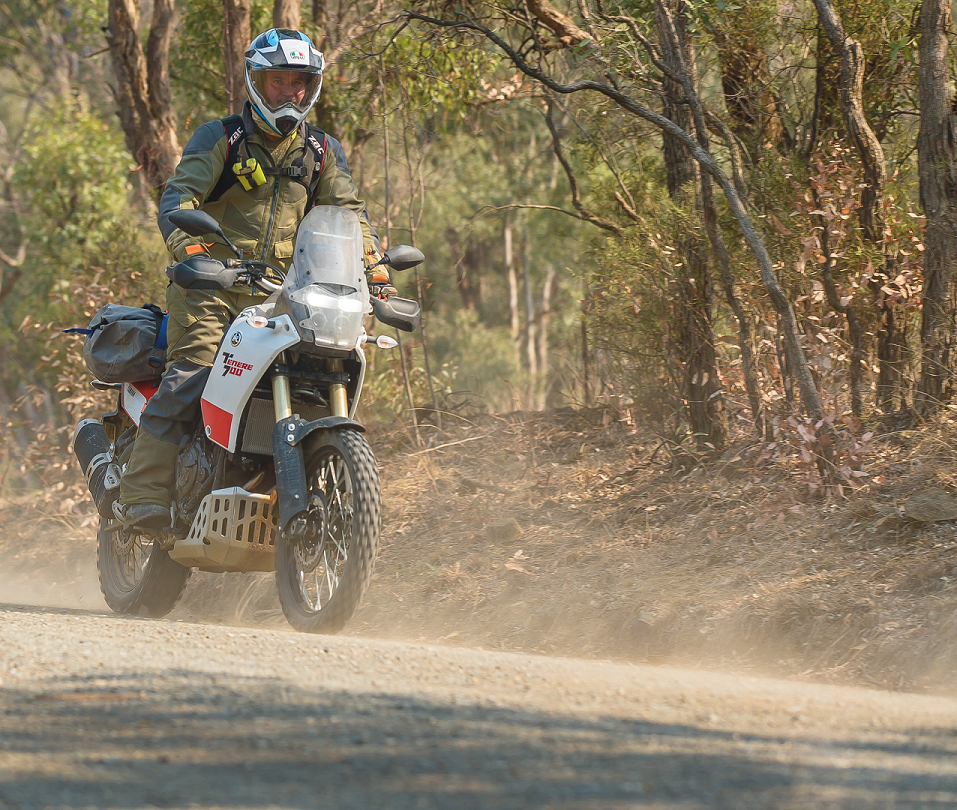



Off-road spec
Things begin to get more serious with the off-road spec.
The skidplate, headlight guard and tank pad from the light off-road spec are in place. Then, from the OEM catalogue, comes an Akrapovic muffler, rally seat, monoseat rack, Barkbusters, GYTR brake-and clutch-lever and ProTaper grips.
There’s no doubt this version of the bike is a step up from the base model, but the added cost is something around $3200. Suddenly we’re looking at a bike that costs just a little over $20,000.
In our opinion the value is there…


mostly. Anyone buying a new bike will look at possible crash protection, comfort options and performance enhancements, and everyone will have different ideas on what’s important to them. And at $20,000-plus-change this bike is still keenly priced for what’s on offer.
We liked the rally seat, think Barkbusters should be on every bike, loved the solid rack, found the levers so nice to use we’d happily pay for them even though there’s nothing wrong with the standard levers, and the grips…well, we wouldn’t take the standard grips off and chuck ’em, but grips don’t last long for us. The ProTapers would be a good option at the first change.
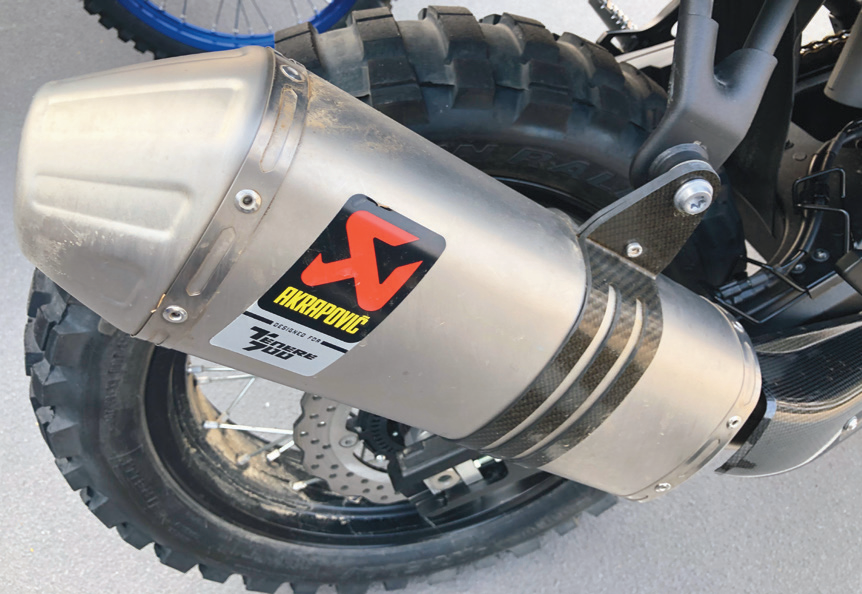

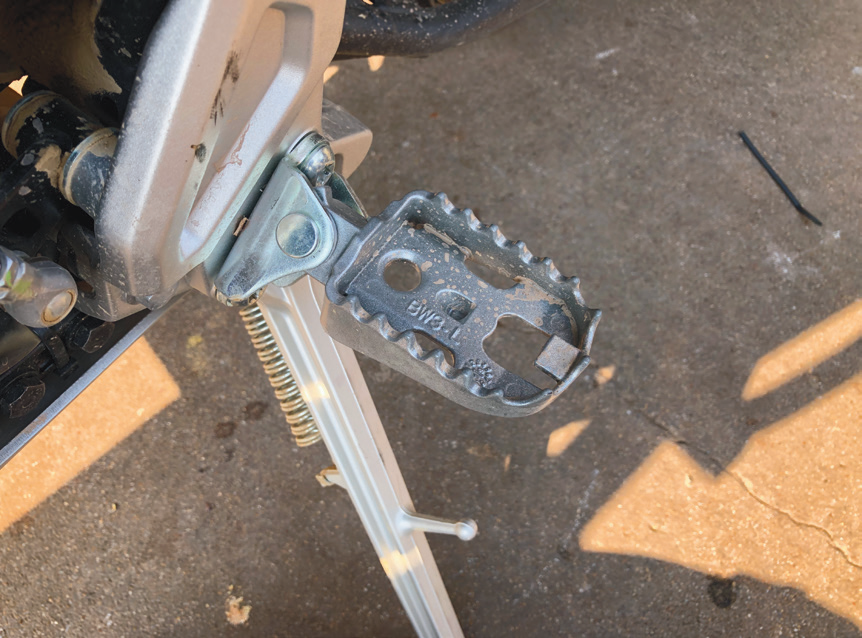

That leaves the Akro, and we have to be honest and say we just couldn’t see $1149 of benefit.
It’s a credit to Yamaha that the stock exhaust performs so well. It sounds similar to the Akro and we honestly couldn’t detect any lift or change in power delivery with the aftermarket pipe.
So we’d think long and hard about changing the muffler.
What we didn’t do was compare weights, stocker versus Akro. If the weight difference is substantial, that may well justify the change-over price, but from a performance point of view, the Yamaha exhaust worked just as well in our opinion.


Roostin’
For the sheer pleasure of riding, the off-road spec Ténéré 700 was a hoot.
The biggest performance enhancement was the same for all the bikes: tyres. The Pirelli Scorpions did a great job. We thought the STRs on the standard bike were excellent dualsport tyres, but the more aggressive knobbies really made a difference.
Barkbusters were a comfort when things got snotty, and the rally seat made the rider position feel just that half-a-whisker more aggressive. We liked that a lot. We didn’t have any trouble securing the luggage to the standard bike, but the rack on the off-road spec Ténéré is a ball-tearer which will carry a good load.
Just on the tie-down points, there’s a couple of little knob-things at the rear of the standard bike and we found them absolutely brilliant for tying on the Yamaha roll-top bag. They were as tough as seven bastards, too. Good stuff.
The GYTR levers just felt nice, and the adjustability was convenient. We wouldn’t rate them as a necessity, but we’d fit them and put the standard levers in the tool kit as spares.
Riding the off-road spec Ténéré was an awesome good time for us. It was comfortable, had just that little hint of aggression about it, and, we admit it, we thought we looked pretty horn on it, especially with the big evil grin we had every time we saw an erosion mound, rocky slope or sandy corner.
For the distance runners Yamaha offers a touring-spec version. The list of add-ons includes:
• Headlight guard
• Engine guard
• Pannier racks
• Panniers
• Centrestand
• Pillion comfort
• Skidplate, AND
• Tank pad.
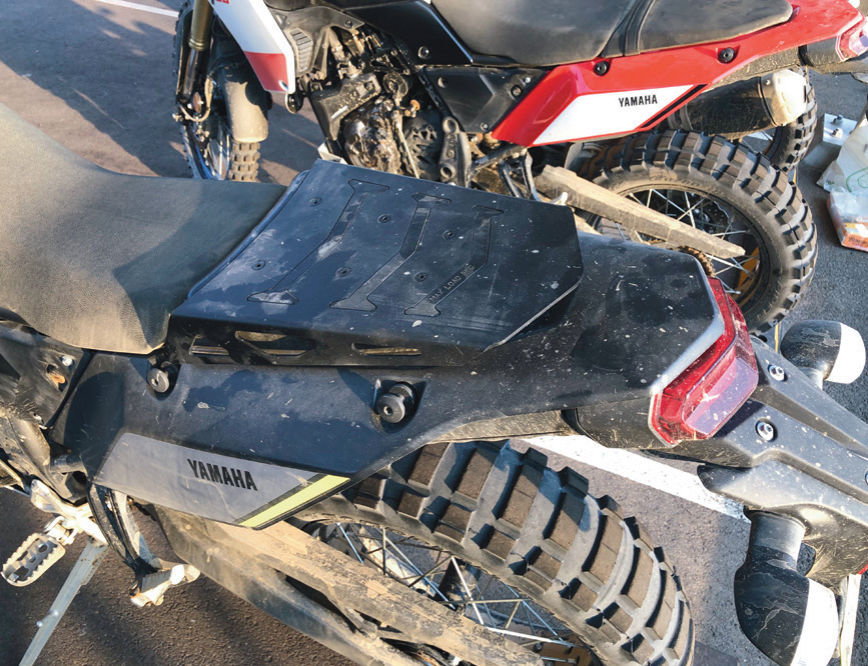



We’ve talked about some of these accessories on the other variations so we won’t repeat ourselves. The big additions on this variant are the panniers and centrestand.
We forgot all about the centrestand until we copped a flat. Unfortunately we weren’t on the touring-spec bike when that happened, and we thought we might burst a pooper valve trying to hoik the bike up onto a fallen tree. You can bet we were suddenly prepared to pay big money to have a centrestand if someone had had one then and there. They can be a godsend to adventure riders, especially with a fully loaded bike.
The panniers will be another accessory that won’t suit everyone.
We’ve warmed to hard panniers for long-distance riding and the pair on the Yamaha are good’ns. They stick out a little ways, but there’s nothing to be done about that. They’re strong, lockable, and, best of all, are easy-peasy to fit and remove. Panniers and pannier racks will add most of $2000 to the cost of the bike, but they’re good units, and would be a good investment for a serious traveller.


Rock steady
It was on the touring-spec bike we did most of the fussing around with suspension.
We kicked off feeling the forks may have been a little harsh. We couldn’t under-stand why when they were the same forks as all the other bikes – which did their job well in our opinion. Individual tuning will be needed both ends of course, but we felt the components worked well – and Yamaha postulated the extra weight of the luggage on the rear had changed the geometry enough to effect the suspension’s behavior. We wound up the rear preload to get the bike back on an even keel, an easy process, thanks to the external preload adjuster for the shock hidden in front of the rear wheel. Click, click, clickedy-click and we were good to go.




on and off in an instant to store in overnight accom.
Then Yamaha’s Peter Payne, Mr Clean himself, lay down in the dirt (true!) and counted the compression clickers on the forks to make sure everything was stock.
We were enjoying a blueberry muffin from the support truck at the time, but he dust-clouded over to tell us all was as it should be.
We’re still not sure we weren’t imagining it, but full marks to Yamaha for going to such lengths on our behalf. We appreciated it. The bike worked well and handled with the same authority as all the others we rode.
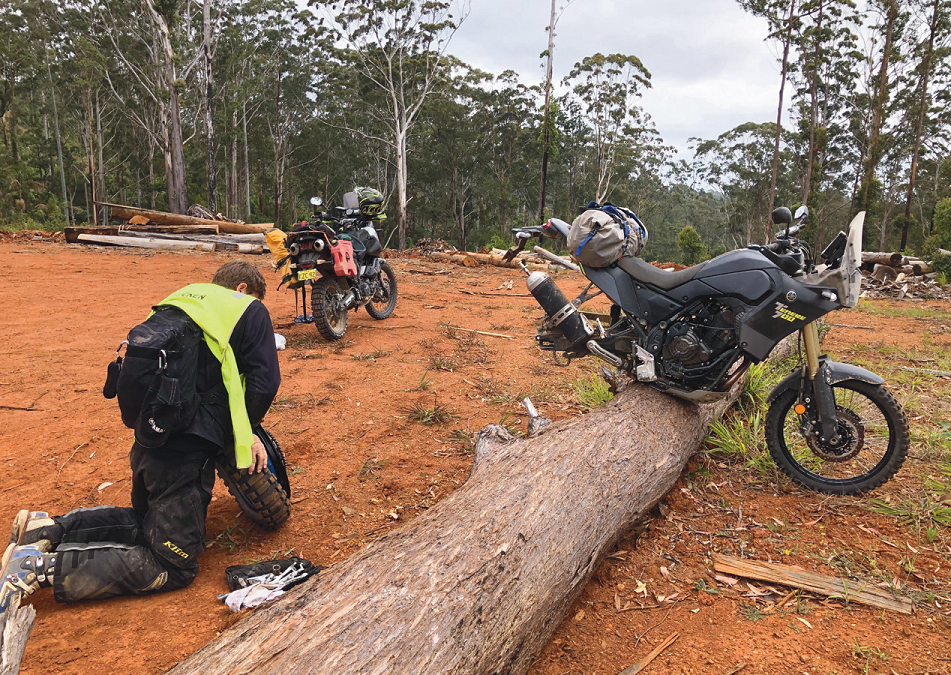

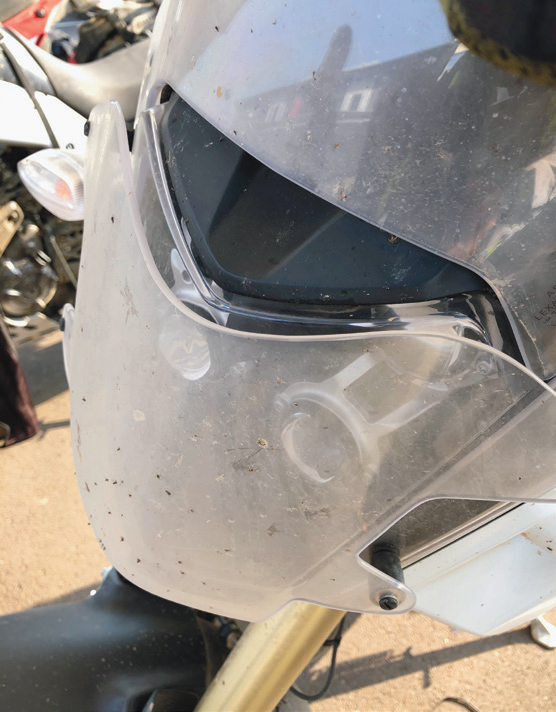

Distance runner
We really like the touring-spec Ténéré. It was comfortable, still performed well, even with luggage, and the crash protection and the centrestand are entirely sensible additions every long-distance rider should consider.
We haven’t said anything about the headlight guard which was on a couple of different-specced bikes, and that’s because we didn’t see it doing its job. We copped a few flying rocks here and there, but didn’t see any hit headlights. It’s one of those things you don’t know you need until it saves your bacon. We did see a lot of dust collect on both the guard and the lights, and it’s a bit of fussing around to pull the cover to clean the inside surface, but well worth the trouble.
Speaking of dust, the LCD instrument panel is tough to read when it gets dusty.
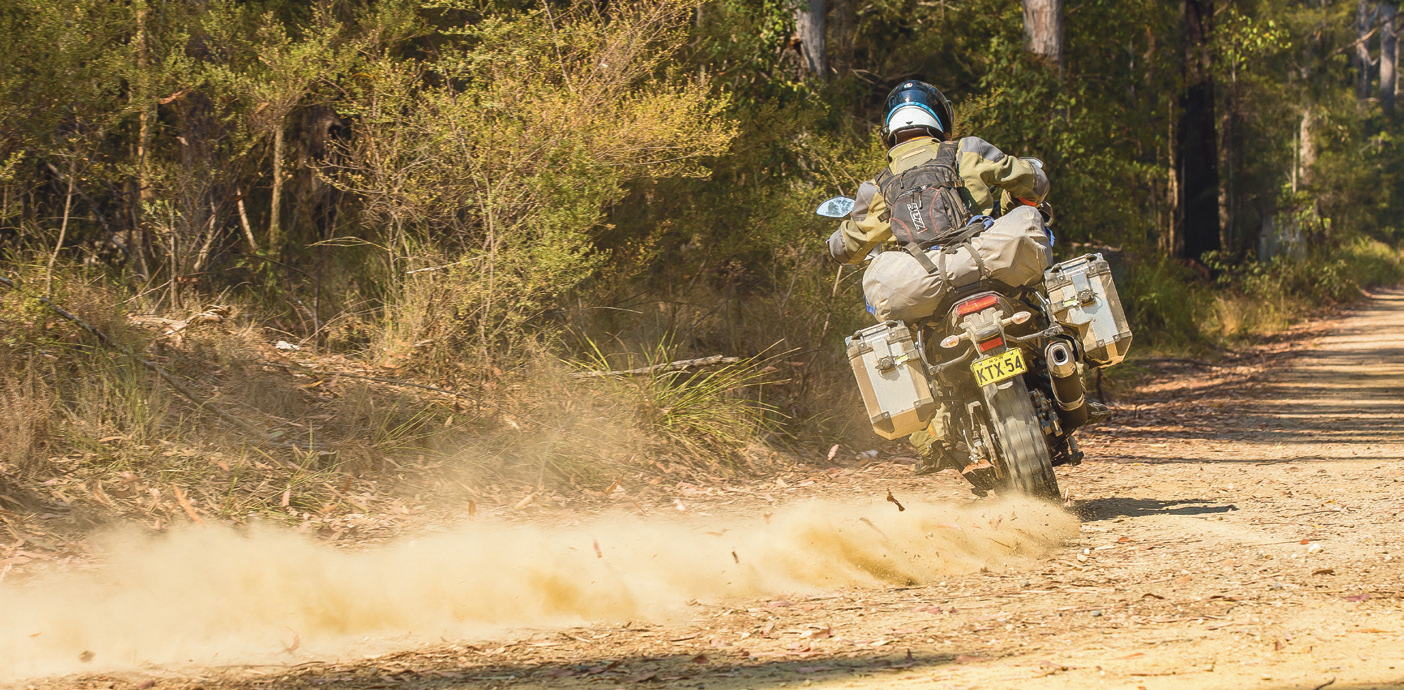

coped well and the handling didn’t seem to suffer at all.
Yamaha Ténéré 700
Recommended retail (including GST): $15,499.
Ride-away price as we go to print: $17,149
Web: www.yamaha-motor.com.au
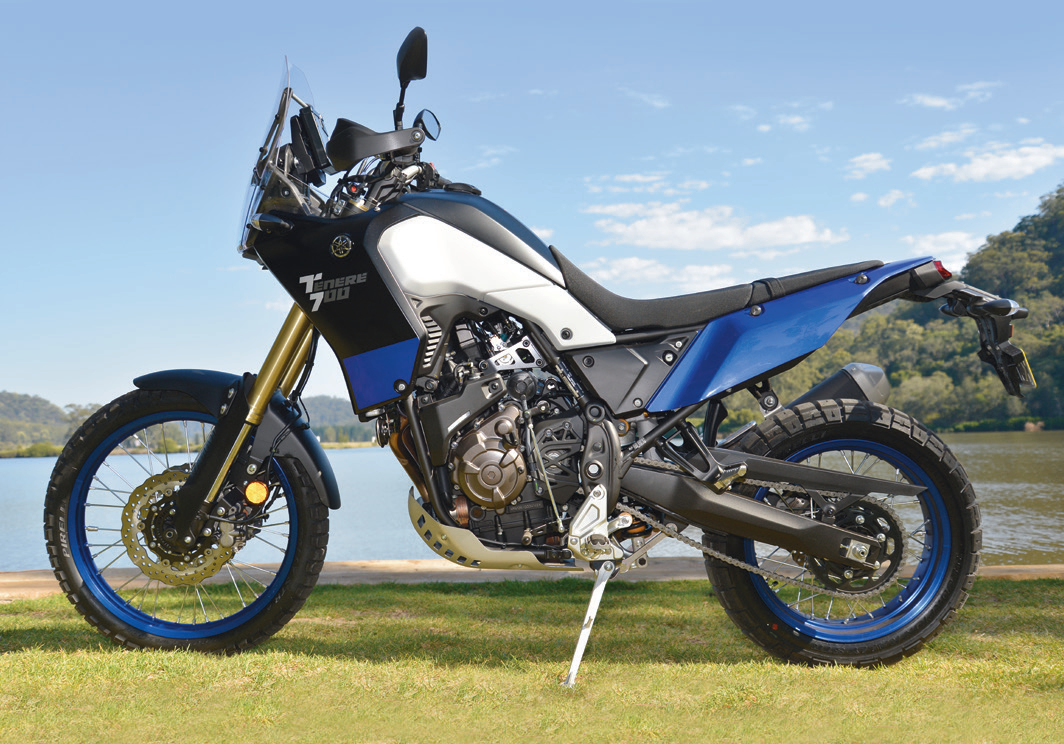

Engine type: Two-cylinder, four-stroke, liquid-cooled, DOHC, four-valves per cylinder
Displacement: 689cc
Bore x stroke: 80.0mm x 68.6mm
Compression ratio: 11.5:1
Maximum power: 54.0kW (72hp) @ 9000rpm
Maximum torque: 68.0Nm @ 6500rpm
Lubrication system: Wet sump
Clutch type: Wet, multiple disc
Fuel management: Fuel injection
Ignition system: TCI
Starter system: Electric
Transmission system: Constant mesh, six-speed
Final transmission: Chain
Frame: Double-cradle steel tube chassis
Front suspension system: Upside-down telescopic fork
Front travel: 210mm
Rear suspension system: Swingarm (link suspension)
Rear travel: 200mm
Front brake: Hydraulic dual discs, two Ø282mm
Rear brake: Hydraulic single disc Ø245mm
Brake system: Switchable ABS
Front tyre: 90/90 R21 M/C 54V M+S – spoked wheel with Pirelli Scorpion Rally STR
Rear tyre: 150/70 R18 M/C 70V M+S – spoked wheel with Pirelli Scorpion Rally STR
Overall length: 2365mm
Overall width: 915mm
Overall height: 1455mm
Seat height: 870mm
Wheelbase: 1590mm
Minimum ground clearance: 240mm
Wet weight (including full oil and fuel tank): 204kg
Fuel capacity: 16 litres
Service intervals: First service at 1000km. Oil every 10,000km. Valves every 40,000km
Colours: Ceramic ice, Competition white, Tech black
Warranty: 24 months, unlimited kilometres, parts and service
YMA Accessories
Yamaha offers a good selection of Yamaha-branded accessories for the Ténéré 700. We used the Yamaha roll-top bag called the ‘Waterproof rack pack’ on this ride and it was a total pisscutter. It copped some serious abuse and hacked the pace, no problem. Here’s a list with prices:
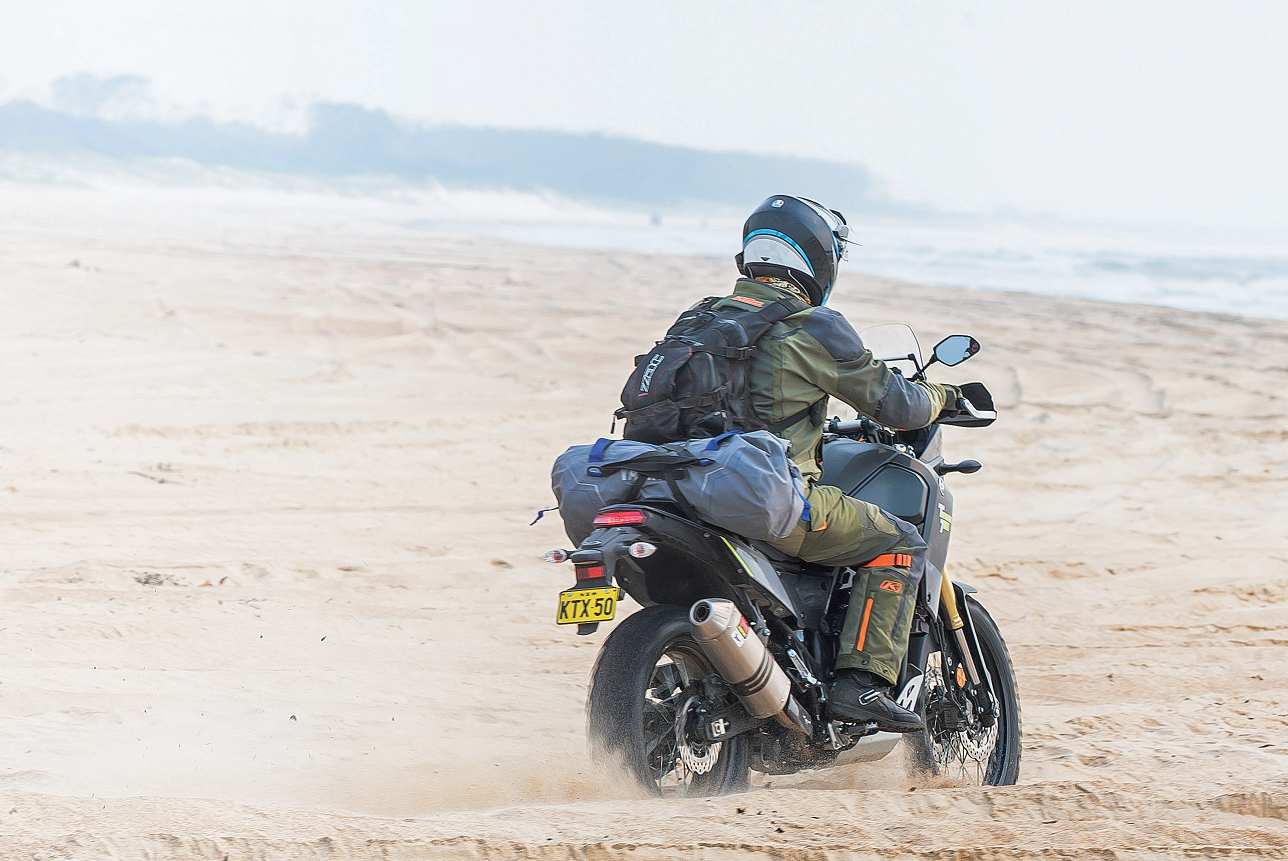

• Skid plate $466.50
• Akrapovic muffler $1149
• Headlight guard $172.70
• Rally seat $596.30
• Monoseat rack $308.10
• Tank pad $39.94
• Barkbusters $171.90
• GYTR clutch lever $151
• GYTR brake lever $188.27
• ProTaper grips $19.95
• Engine guard $424.40
• Side case stay set (pannier racks) $560.60
• Left case $721.80
• Right case $689.10
• Main (centre) stand $545.80
• Pillion comfort $343.70
• Skidplate $466.50
• LED fog lights $820.04
• Grip heater $321.48
• Licence-plate holder $210
• Handlebar risers $114.40
• Chain guard $169.70
• Waterproof rack pack $124.70









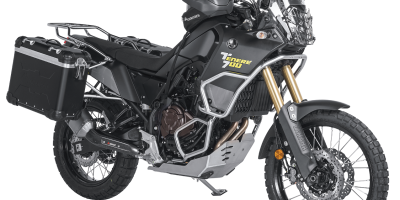
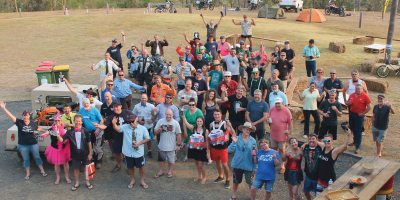




Comments